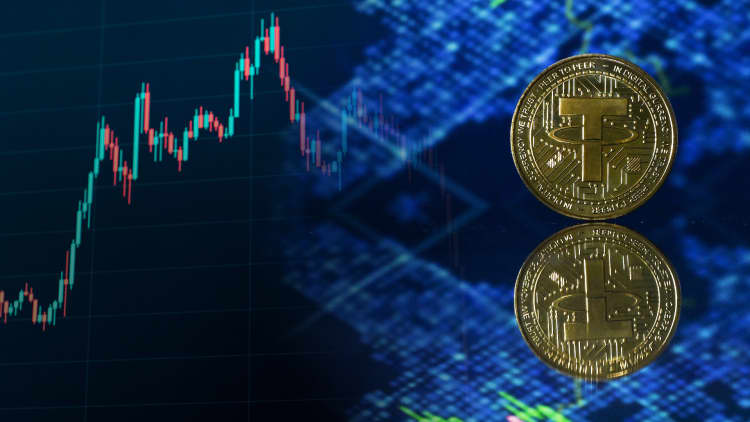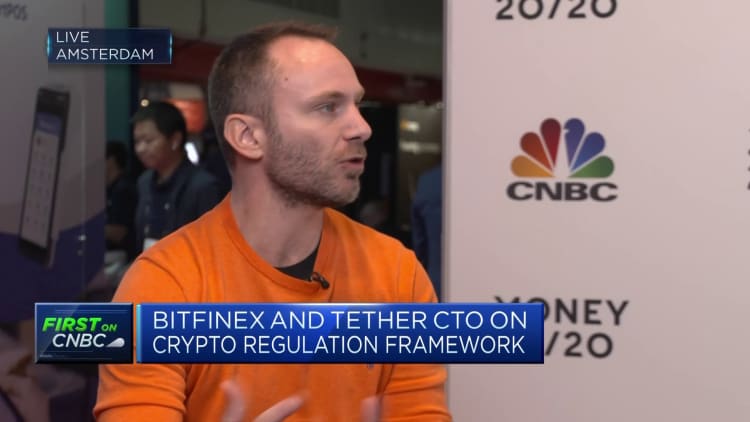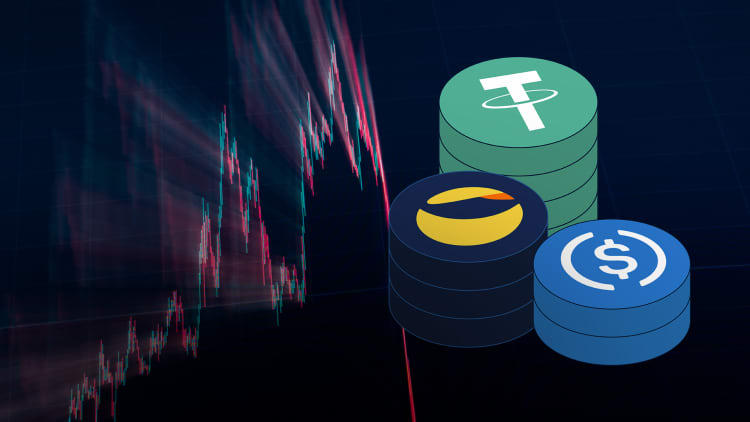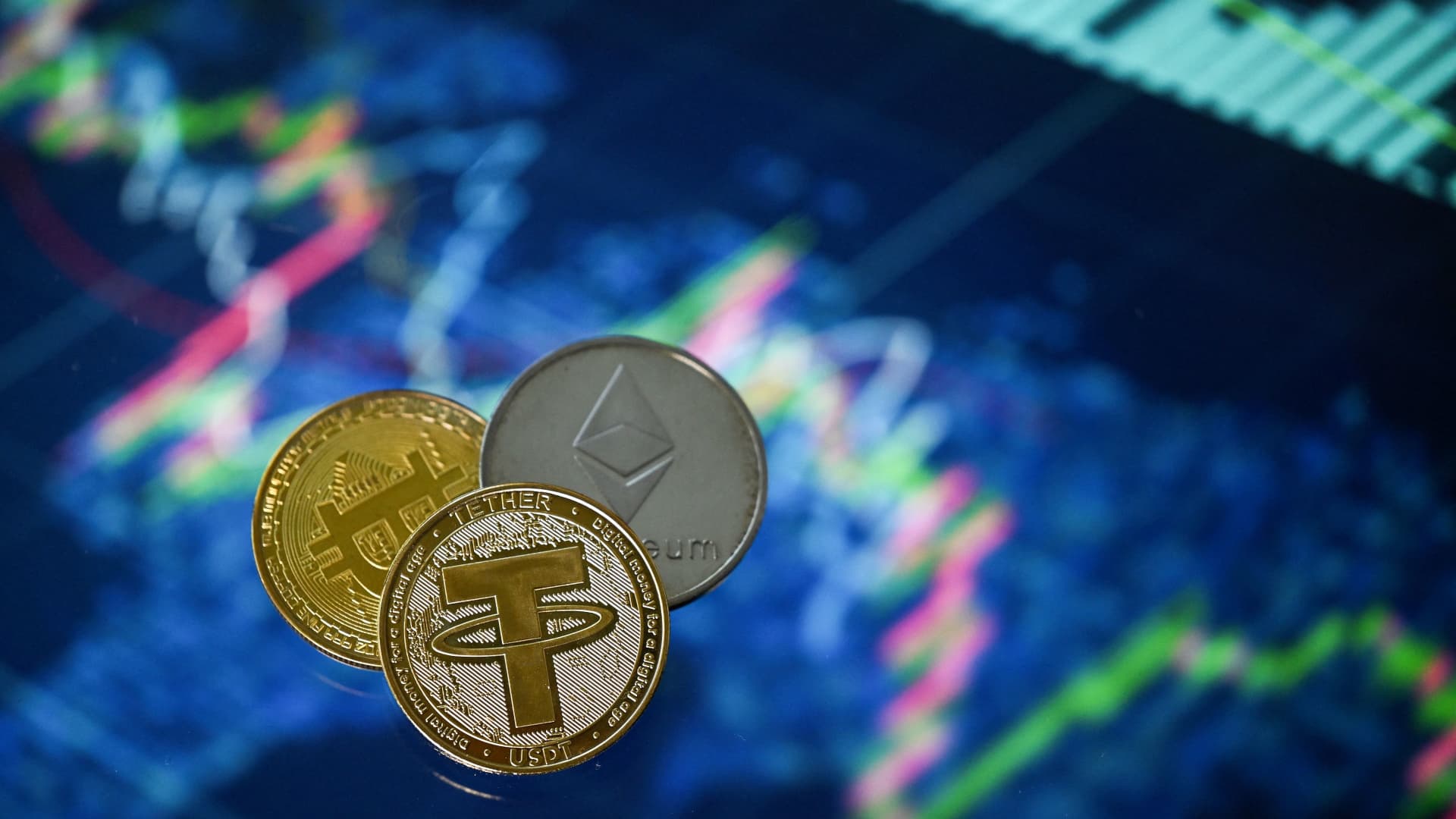A picture taken in London shows gold-plated souvenir cryptocurrency tether, bitcoin and ethereum coins arranged beside a screen displaying a trading chart, May 8, 2022.
Justin Tallis | Afp | Getty Images
Paolo Ardoino, the chief technology officer for Tether, has been promoted to CEO of the stablecoin company, in a surprise move. Ardoino will take the reins from Jean-Louis van der Velde, a secretive crypto executive and entrepreneur, who has for years been the company’s boss.
In a press release Friday, Tether said that Ardoino will lead Tether from December 2023, succeeding van der Velde. Van der Velde will take up a new advisory role at Tether while still holding the position of CEO at Bitfinex, a crypto exchange that is closely associated with Tether and operated by the same Hong Kong-based parent company, Ifinex.
Ardoino will still serve as Tether’s chief technology officer while taking on his additional duties as CEO, Tether said. He will also continue serving as the chief strategy officer of Holepunch, a peer-to-peer communications network launched by Tether, Bitfinex and infrastructure platform Hypercore.
Ardoino first became involved in crypto when he joined Bitfinex in 2014. He joined Tether as chief technology officer in 2017.
Tether is one of the largest stablecoin operations in the world. Its USDT token, which aims to maintain a one-to-one peg to the U.S. dollar, is the biggest stablecoin by market value with more than $80 billion worth of tokens currently in circulation. Stablecoins are a vital part of the crypto market that help traders move in and out of digital tokens, anywhere in the world, around the clock.
In a statement, Tether’s van der Velde said that Ardoino is “extremely well-suited to lead Tether,” adding: “I believe Tether is poised to continue its rapid growth, with a continued focus on emerging markets and transformative technology.”
The departure of van der Velde, an executive who has barely ever appeared in public, comes as Tether has faced scrutiny over transparency. Many market observers had pointed to the lack of the former CEO’s public facing attitude as a sign Tether is not transparent.

Ardoino has for years effectively been the face of Tether. He has held multiple interviews with the media and appeared on podcasts, often to defend his company and its associated USDT token from scrutiny.
In a CNBC interview at the Money 20/20 conference in Europe in Amsterdam earlier this year, Ardoino said the company would release a full audit “eventually.”
“We’re working on it,” he added.
Explaining why the company had not yet completed a full audit already, Ardoino said this is because none of the big four auditing firms were willing to work with an industry that lacks regulation. While regulations are coming into place around the world for crypto, there is still no all-encompassing framework for the industry in place.
That is soon set to change with the EU’s Markets in Crypto Assets (MiCA) regulation around the corner. This would require stablecoins to keep a certain level of assets including more quality assets in their reserves, as well as publicly disclose their reserves. However, MiCA won’t fully apply until December 2024.
Van der Velde, on the other hand, has largely operated in the shadows, helming Tether without appearing in public much or speaking to the press.
Tether ran into a major controversy last year following the collapse of a rival stablecoin called TerraUSD, or UST. UST’s price fell to zero after crypto investors flocked out of the coin en masse due to fears over its backing.

Not long after then, Tether’s USDT also began to deviate from its U.S. dollar peg, stoking concern over whether it was truly fully backed by dollars. That led to calls for Tether to increase transparency and run a full audit of the reserves behind USDT.
For its part, Tether said that its coin is always backed by dollars and dollar-equivalent assets including government bonds. Tether is also backed by other assets, including crypto tokens like bitcoin, and even gold.
Tether’s reserves rose to more than $86 billion in the three-month period from April to June. During that quarter, the company also says it booked a profit of more than $1 billion, up 30% quarter-over-quarter.
The company is sitting on a stockpile of U.S. Treasury bills, which are currently yielding about 4.6%. Tether makes money from various fees, and issuing loans to other institutions, and investments in digital tokens and precious metals.
In 2021, Tether settled with the New York Attorney General’s office for $18 million over claims that it and sister company, Bitfinex, had moved hundreds of millions of dollars to cover up the apparent loss of $850 million of commingled client and corporate funds.
As part of the settlement, Tether agreed to offer frequent quarterly reports detailing its reserves.
Tether continues to face sharp regulatory scrutiny. The U.S. Department of Justice is reportedly investigating Tether executives over allegations that they committed bank fraud in the early days of running the company, according to Bloomberg.
– CNBC’s Arjun Kharpal contributed to this report
WATCH: How a $60 billion crypto collapse got regulators worried


